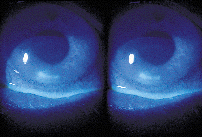Reserve fluoroquinolones for corneal infections
Fluoroquinolones, the latest and possibly last generation of antibiotic agents, offer practitioners a tool in their armamentarium that covers a wide range of bacteria that can infect the eye. Some doctors worry that the broad spectrum of activity may lead to overuse when first-generation antibiotics can resolve most routine infections. This overuse could contribute to bacteria developing resistance to the antibiotics, which would limit their usefulness in the future.
Try first generation first
Most surface conditions of the eyelids and conjunctival sac that are seen in a primary care optometric practice will be resolved through the use of standard antibiotics, Jimmy D. Bartlett, OD, FAAO, a professor of optometry and pharmacology at the University of Alabama at Birmingham, said in an interview with Primary Care Optometry News.
“In the majority of clinical circumstances, most optometrists will do very well sticking with the first generation of anti-infective agents. The aminoglycosides, gentamicin and tobramycin, are still excellent, and most patients who have bacterial conjunctivitis will still do very well with those,” Dr. Bartlett said.
Gentamicin and tobramycin do not fare as well in handling streptococcal infections, particularly in children, where there is a higher incidence of bacterial conjunctivitis caused by Streptococcus, he said. To cover streptococcal infections, Dr. Bartlett recommends Polytrim (trimethoprim sulfate, polymyxin B sulfate, Allergan). Polytrim also has been shown to be as effective against staphylococcal blepharitis as bacitracin and erythromycin ointment.
Despite the wide range of coverage provided by the first generation, some doctors may be relying too heavily on the fluoroquinolones, he said.
“Some doctors use Ciloxan (ciprofloxacin, Alcon) for every case of conjunctivitis that comes in the door, and I don’t think that’s right, because those are going to respond quite nicely to standard antibiotics,” Dr. Bartlett said. “With these new antibiotics, we need to reserve them and put them on the back burner. We’ve seen a tremendous increase in the prevalence of resistant strains just in the past decade.”
Fluoroquinolones are a good back-up
 ---Untreated pseudomonal ulcer: This resulted from misuse of extended-wear contact lenses.
---Untreated pseudomonal ulcer: This resulted from misuse of extended-wear contact lenses.
The strength and utility of the fluoroquinolones make them a good safety net when a first-generation agent fails, Chris J. Cakanac, OD, FAAO, in private practice in North Huntingdon, Pa., told Primary Care Optometry News.
“As someone who has seen a lot of infectious disease, it’s nice to have an antibiotic on which you know you can fall back,” he said. “I don’t think you should mortgage the future on the drop by handing it out left and right. It is used for just about anything from any infection to no infection — such as prophylactically for surgery now.”
At the same time, knowing how effective the fluoroquinolones are makes it difficult to advise against using them, he said.
“I don’t think you can make a recommendation and say use them only for ulcers,” Dr. Cakanac said. “It’s something that you have to weigh each time you prescribe them. If a more common antibiotic will take care of a routine conjunctivitis, I’d tend to lean that way just because I would like to preserve the effectiveness of fluoroquinolones, but that’s a hard recommendation to make when they are so effective and easy to use.”
Fluoroquinolones for corneal conditions
While the first-generation antibiotics are well suited to conditions such as conjunctivitis and blepharitis, infections and diseases affecting the cornea should be treated using fluoroquinolones, Dr. Bartlett said.
“If I am looking at a contact lens patient who comes in with a lot of epithelial compromise and it looks like there may be an early infiltrate or subepithelial infiltrate, but I’m not sure if it’s a sterile or an infectious infiltrate, I will go with a fluoroquinolone prophylactically, four times a day,” he said.
An advantage of fluoroquinolones over fortified antibiotics is that, instead of one drop for gram negative and one drop for gram positive, patients only need to instill one drop, Dr. Cakanac said. They also are cheaper and easier to obtain than fortified antibiotics.
With fortified antibiotics, if one is alternating two different antibiotics, one for gram positive and one for gram negative, every other drop is not going to kill the offending bacteria in most cases, because it is uncommon to have a mixed infection, said Nicky R. Holdeman, OD, MD, executive director of the University Eye Institute and chief of medical services at the University of Houston. The patient will experience the potential toxic effects and the cost associated with the second medication, even if it is not helping treat the infection.
In general, Ocuflox (ofloxacin, Allergan) and Ciloxan are both very effective agents, Dr. Bartlett said. He favors Ocuflox because studies have shown it maintains higher tear film levels for longer periods of time and has better corneal penetration.
Another difference is that when using Ciloxan every 1 to 2 hours for 2 to 3 days, the drug may precipitate out of the solution to form white chalky lesions on the corneal ulcer, he said. This is usually a benign event, but it can occasionally inhibit the healing process.
Dr. Cakanac has a slight preference for Ciloxan for corneal ulcers because it is more potent. When treating a corneal ulcer, penetration is not as important because there is already an epithelial defect that allows penetration, he said.
Ciprofloxacin also has been shown to be slightly better for Pseudomonas, so Dr. Holdeman will typically choose Ciloxan over Ocuflox for contact lens wearers who have infectious lesions.
“From an efficacy point of view, one is probably just as good as the other for what we are doing in primary eye care in treating ocular surface infections and most of the smaller to medium-sized corneal ulcers,” Dr. Bartlett said.
Another important feature of the fluoroquinolones is their low toxicity, which makes them a good choice for patients who have developed a toxic reaction to other antibiotics, Dr. Cakanac said.
Used as empiric therapy
 ---Corneal infiltrates caused by extended lens wear: The clinical dilemma is determining if they are infectious.
---Corneal infiltrates caused by extended lens wear: The clinical dilemma is determining if they are infectious.
Fluoroquinolones also are valuable as empiric therapy of corneal infections while waiting for culture results to determine the causative organism and the most effective antibiotic to treat the condition.
Many corneal ulcers are caused by gram-positive organisms, such as Staphylococcus aureus, Staphylococcus epidermidis, Streptococcus and Streptococcus pneumoniae, against which the fluoroquinolones are less effective, Dr. Holdeman said.
“If I think I have an infectious process that is overlying or near the visual axis or on cross section appears to be deep, I am not going to treat that with a single fluoroquinolone. Some times until culture results are available, I will use Ciloxan or Ocuflox in conjunction with something like Ancef (cefazolin sodium, SmithKline Beecham), which is a first-generation cephalosporin and has better gram-positive coverage,” Dr. Holdeman said.
Some doctors recommend fortified gentamicin or tobramycin in lieu of fluoroquinolones, but combining Ocuflox or Ciloxan with a first-generation cephalosporin will do well and may improve compliance, he said.
“Fluoroquinolones are less toxic to the cornea. They are more readily available,” Dr. Holdeman said. “They are less costly. They do not have the irritation with instillation that the fortified drugs do. If you can improve cost, comfort and convenience, compliance goes up. You want them to get the drug in the eye, so I think there is some benefit of using commercially available drugs because a lot of doctors in smaller towns are going to have trouble getting fortified antibiotics.”
With early peripheral lesions that are at least 3 mm away from the visual axis, are less than 2 mm in size, are less than 20% of corneal depth and have not caused much (< grade 1) anterior chamber reaction or discomfort for the patient, Dr. Holdeman will use a fluoroquinolone alone. At night, he will have the patient use bacitracin or Polysporin (polymyxin B and bacitracin, Warner Wellcome) ointment to cover gram-positive organisms.
Prophylaxis for surgery
The effectiveness of fluoroquinolones has led many surgeons to use them prior to surgery to ward off potential infections.
“You’d like to reduce the risk of endophthalmitis, and you don’t want any infectious process to take over in the anterior chamber or vitreous cavity following invasive surgery. I think surgeons are just being conservative with that and want to do the best they can to reduce the risk of infection,” Dr. Bartlett said.
For prophylaxis, most surgeons at the University of Alabama at Birmingham prefer Ocuflox because of its enhanced corneal penetration, he said.
In addition to their effectiveness against most bacteria that infect the eye, fluoroquinolones are well tolerated by almost all patients, Dr. Bartlett said. “They’re not really toxic — you can use them fairly aggressively on the ocular surface and they don’t cause significant keratitis. They do not cause inflammation of the anterior chamber. They don’t sting or burn to any significant degree,” Dr. Bartlett said.
There is cross-sensitivity between the fluoroquinolones, so if a patient develops a reaction to one, he or she also might have a reaction with the other, he said.
Increasing resistance
 ---Marginal keratitis caused by Staphylococcus and often associated with blepharitis.
---Marginal keratitis caused by Staphylococcus and often associated with blepharitis.
With the widespread effectiveness and availability of the fluoroquinolones, the largest concern about doctors using them for minor infections is that the bacteria the drug is intended to kill will develop resistance to the medication. Some studies suggest this is already starting to happen, Dr. Holdeman said.
“If you look at the studies on drug resistance of the fluoroquinolones, every year the percentage of anti biotic-resistant organisms increases. In 1991 or 1992, it was 10% to 12%. Today, it is between 25% and 30% of either outright resistance or only intermediate sensitivity, depending on the organism,” Dr. Holdeman said. “It should be pointed out, however, that sensitivities are determined by in vitro susceptibility studies and are not always ocular specific.”
For the most part, ophthalmic usage will not contribute much to the increase in resistance by bacteria, he said. Most resistance comes as a result of oral or parenteral usage. “When we use fluoroquinolones topically and they are used in the way and in the frequency they were intended, we are killing the organisms, and dead organisms don’t mutate and don’t become resistant. The problem topically is when people start using these drops once or twice a day and the organisms can develop resistance,” Dr. Holdeman said.
The likelihood of developing resistance also is lessened because fluoroquinolones are DNA gyrase inhibitors, which are more difficult for bacteria to develop resistance to than some of the folate inhibitors and other mechanisms of action for antibiotics, he said.
With a different mechanism of resistance, bacteria should take longer to become resistant to the fluoroquinolones than other drugs, but the risk of ineffectiveness is not eliminated, Dr. Cakanac said.
“Theoretically, the fluoroquinolones shouldn’t develop resistance as quickly as other medications, but time has told us that resistance to any antibiotic, if you use it frequently enough, will occur,” he said. “That’s why I think judicious use of it is probably the best way to go.”
Adding to the concerns about reducing the effectiveness of the fluoroquinolones is the lack of development of new antibiotics, Dr. Bartlett said.
“As you look at the development of new anti-infective agents, there is almost nothing new on the horizon in terms of new ophthalmic antibacterial agents, so I think we are coming to the end of the road in terms of what’s going to be available to us in the foreseeable future,” Dr. Bartlett said.
For Your Information:
- Jimmy D. Bartlett, OD, FAAO, is a professor of optometry and pharmacology at the University of Alabama at Birmingham. He can be reached at 1716 University Blvd., Birmingham, AL 35294; (205) 934-3036; fax: (205) 934-6758. Dr. Bartlett has no direct financial interest in the products mentioned in this article. He is a paid consultant for Alcon Laboratories and Allergan Inc.
- Chris J. Cakanac, OD, FAAO, is in private practice in Pittsburgh and is on the associate medical staff at Jeannette District Memorial Hospital. He can be contacted at 8775 Norwin Ave., N. Huntingdon, PA 15642; (724) 864-7777; fax: (724) 733-5449. Dr. Cakanac has no direct financial interest in the products mentioned in this article, nor is he a paid consultant for any companies mentioned.
- Nicky R. Holdeman, OD, MD, is executive director of the University Eye Institute and chief of medical services at the University of Houston. He can be contacted at 4901 Calhoun St., Houston, TX 77204; (713) 743-1886; fax: (713) 743-0965; e-mail: NRHoldeman@uh.edu. Dr. Holdeman has no direct financial interest in the products mentioned in this article, nor is he a paid consultant for any companies mentioned.
